They tried to stop the war, before the spark was lit, but the smallest sparks are hard to catch, and in the dark it spread. They tried to stop the war, before the plans were made, but ideas go far, papers hide well, and then it was too late. They tried to stop the war, before the rot could spread, but spread fast it did, for realm to realm, no one would lend a hand. They tried to stop the war, before they were cut off, but the damage done was too much, too big, and now they’re all alone.
The war, my friends, is at their door, with frost and fire and sword. They could not stop its lengthy march, could not delay the fight, for sparks are small and plans quite hidden, and lost without some light. Rot is easy to ignore, when in another’s home, and try as you might to hold the door, you can’t do it alone. The gates are gone, the wood in splinters, the war is here at last. So all that remains, all that is left, is to fight and hope it’s enough.
Welcome back, one and all, to the column fit to hold the hammer. Welcome to the column that follows the moniker of Thor. Welcome back. . .to Worthy.

It has been a while, friends, since we last had missives. Last we spoke, the winged tigers of Malekith were on their way to Midgard, to WAR. Thor was brooding over his feelings of inferiority and impotence in the face of a war he cannot stop and an indifferent universe. Odin was sitting, finally alone, having driven everyone away, while Freyja was on Midgard, preparing to lead whoever remains into the fight that she knew was incoming.
It’s all been building to this, to an event so big, it couldn’t be contained by Thor’s book and had to become its own.
For now, for those of you who need a (not so quick) refresher of the events up until now, Part 1, Part 2, and Part 3 of Worthy are ready to be (re)read. Spoiler warning. . .duh.

& Matthew Wilson
“War of the Realms” Year 7
And lo, the heavens were torn asunder, for war. . . war had come to Midgard.
When it was announced at NYCC 2018 that the War of the Realms, the slow-building threat in the back of Aaron’s Thor books, was, one, finally on our doorstep and, two, to become “War of the Realms,” a six-part Marvel event, the decision was all at once a shock and also the only logical step for a story as large as this one. Six years in the making, if there was any story that Marvel would spin off into its own event, the War of the Realms was it. The scale is there in the name, the groundwork had been laid and it would be too strange to not have it spill out into something massive.
It also meant that the story could escape the orbit of the Odinson and expand out to include the entirety of the Marvel universe.
I have made the case that each Thor book, each era, has had a distinct feel and tone, informed and set by the title, which is then bolstered by a change in (main) artist — Ribic for “God of Thunder,” Dautermann for “Thor” (2014) and “The Mighty Thor,” and Del Mundo for “Thor” (2018). As such, it wouldn’t make sense to have the war occur in the pages of “Thor” (2018) — he simply wasn’t the focus, the lynchpin with which the whole of the book rotated around.
The story had to focus on more than just Thor, have a grander scope, and be able to include far more into the focus of its action. We would need a new title, and the artists that did more work than any other charting the course of the war as it wormed its way through the realms.
We would need Dauterman and Wilson.
Continued below
Issue #1 pg. 15-16. Art by Dauterman. Colors by Wilson. Letters by Joe Sabino.
Before I get into the nitty gritty of the event, I wanted to praise the ever loving shit out of these two and Joe Sabino. Six issues, two of which were oversized, in three months, not a single one delayed or late with an intense level of quality and detail, is a testament to both their planning prowess and to their talents as artists. Reading the issue #1 Director’s Cut makes that talent all the clearer, breaking down how much changed from script to art, how much was highlighted and solidified by the coloring, and how well integrated the lettering was, keeping it legible without devouring the work beneath it, dense but not overcrowded.
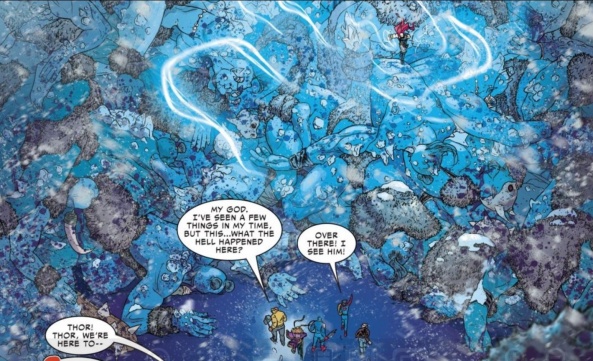
Issue #3 pg. 21. Art by Dauterman. Colors by Wilson. Letters by Sabino.
This is what an event should feel like, should look like, and they brought their all to it. And, honestly, I couldn’t see any other team but them on this book. Dauterman knows how to bring the scale of the Asgardian world to life in all its brutal glory without letting it get too gory or dark. Wilson’s colors are integral to maintaining that balance and keeping the slick, digital look without letting it sink too far into the uncanny shininess. And Sabino, well, as I said before, he has been there the whole time, keeping things together and making the experience such a joy to read. Damn do I love his Asgardian font.
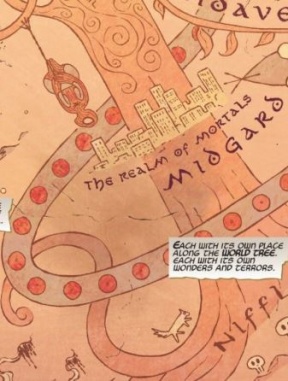
Sabino. You know who by now.
Enough craft, let’s talk craft. Right from the get go, we know “War of the Realms” is going to be different. Far from the focused character studies of “Thor” (2018,) this is an epic, recounted in massive tomes in the library of the gods. It opens on a fully black page, with two, short caption boxes before expanding out, onto a two-page spread of a map of the ten realms, complete with Ratatoskr and Jörmungandr and a one Spider Man. A creation story, familiar yet distinct, telling us what happened in the beginning, what happened after, and how it all was threatened by a mighty war. Narration that comes, not from any character present, but from a far flung source, 3rd person and omniscient.
Then, we are treated to the credits page, which proudly proclaims: Chapter One: “The Last Realm Standing.” It is a grim reminder of all the events that have led us to this point and the next few pages, for the war does not begin right away. Instead, Aaron chooses to set the stakes and the scene some more, with Odin being ambushed in his empty Asgard and Loki crashing to Earth on Thor’s boat. We didn’t need these moments, the event could have simply begun with Malekith’s invasion. However, that’s where the magic is.

Dauterman. Wilson. Sabino.
Aaron has spent six years building to this within his “Thor” titles. Six years spent simulating, in real time, what it’s like to watch a war arise, to watch the pieces fall into place but never knowing how or when it would all come to a head. But this isn’t one of those books. This is an event; this is the “War of the Realms.” Therefore, he must take the time to have it stand on its own, to have its own momentum and to feel like the war that it is, rather than a compressed recounting of it. Plus, no war is ever just its main battles, no war truly begins out on the battlefield.
That is why, despite this being “War of the Realms” issue #1, the war does not actually arrive on Midgard until the last third of the issue. . .and why it’s a bloodbath.
From well before the war arrived, it was clear that it would not go well for Midgard. The might of nine realms, some conquered, some allied, were against them. Yes, the heroes are powerful but against an army, there is only so much that can be done, even in the city with the most superheroes per square mile.
Continued below
Dauterman. Wilson. Sabino.
The choice to focus entirely on NYC (save for quick asides to Jotunheim and Asgard) in issues #1 and #2 is telling in how Aaron structures the narrative to have the most weight with the most economical storytelling. He doesn’t need to show Malekith’s army conquering the world: he just needs to show them conquering one city, one powerful city, wholly and completely, to establish the stakes of the narrative.
NYC is a proxy for the world because if the book makes us believe that NYC, with all those heroes could be taken down with as much precision, destruction and prejudice as it was, then we can believe the whole world was taken down at the same time in a similar fashion. By not constantly cutting between simultaneous battles here at the fall, the book can spend more time developing the characters, giving greater weight to the action scenes we can see, and creating the requisite despair necessary for the final page of issue #2 to be as powerful an ending as it is. Where do we go from here, that pages asks? If the world is lost, how do we find it once again?
The answer: you change the nature of the war.

Issue #2 pg. 20. Art by Dauterman. Colors by Wilson. Letters by Sabino.
Issues #3 and #4 fragment their narratives into bite-sized vignettes — slices of missions that show the main campaigns of the resistance and strikeforce phase of the war. The frenetic pace and chopped up action creates an air of unease and the feeling that we’re watching these from a general’s perspective now, rather than from a soldier’s. It is just as economical as Act 1 in terms of what it dramatizes on the page, what it leaves for the tie-ins, and what is inessential to depict, but the focus has shifted from depth to breadth. This is where the event goes from being great to something special. Were Aaron to have continued to focus on NYC, as he did in Act 1, the book would have failed at its central mission of being about the war.
I know, I know. I just argued that it was a brilliant move not to open the narrative up in the first two issues but hear me out.
Getting stuck in the weeds and diluting the focus too much would have bloated the event without adding much to this core book. It is unimportant how the heroes lost the opening campaign around the globe, only that they did. It had to be believable while also focusing mostly on the Asgardians (and Jane,) all of whom were in NYC at the time. Up until now, they were our entry point into this conflict and as such, the narrative had to do its due diligence in positioning them physically, mentally and emotionally before getting to the larger plot and widening the aperture of its lens.

Dauterman. Wilson. Sabino.
Once that is done, however, the feeling that this is indeed a war and not just a big battle — ala The Avengers — needs to be conveyed. Aaron does this by both showing what is going on around the globe but also by checking in with Malekith and jumping between the major offensives launched by and against All-Mother Jane’s forces. We have soared to a birds-eye view of the action so that the far reaching effects of the war can be viewed, touched on, and the important bits highlighted.
A big problem with modern comic book events, especially at Marvel, is that they spill out into their tie-ins for essential narrative moments. Without them, the main story loses its weight and events fall flat, succumbing to the “Want to know how this important crystal came to be in the possession of Captain Captain? Read Uncanny X-Peeps #42.MU to find out!” That is avoided here without discounting the importance of the tie-ins.
Let me explain.

Art by Dauterman. Color by Wilson. Letters by Sabino.
Issue #3 is, in essence, the greatest hits of the three “Strikeforce” issues. They are not rehashes of pages or scenes but instead complementary to them, showing only the moments that matter to this main narrative. Spider-Man and co. looking for Thor, Freyja and Co. going for the Black Bifrost, and Captain Marvel and Co. vs Malekith, as we cut between them, a rhythm forms as the battles occur. The power of the storytelling is such that the details of how Freyja gets the sword at the start of issue #4 doesn’t matter because there is a logical progression of events on the page that lets us extrapolate that time has moved forward, that the battle progressed, and over the course of that period, she gained the upper hand.

Loving the murder eyes. Issue #5 pg. 5.
Dauterman. Wilson. Sabino
We are kept apprised of the shape of the war at all times, once it is in full swing, so that when the final battle looms, when victories are won and reinforcements are called, we feel the tide of war start to change, and so, just as with Act 1 to 2, Act 2 to 3 changes the feeling once again. Now, instead of only being split in space, with a minor amount of time differentials, we are split in time as well, jumping between Thor’s last gambit and his triumphant return to Midgard, hammer in hand, lightning on his fingertips. Act 3 is as much a hybrid of the previous two as it can be, closing out “War of the Realms” in the ways all good epics do, by hearkening back to the start and by showing the growth of our heroes.
Issue #5 is as fragmented as 3 & 4, showing the final battles of the war as the forces and generals of Malekith’s armies are overthrown, defeated and turned back. It is as triumphant an issue as it can be but instead of opening on that, instead of continuing from Thor’s return, we jump to him going away again before cutting back to Thor flying from battle to battle, lending assistance where needed, throwing lightning to boost morale and continuing to be the brutal warrior we know him to be. We open and close on the promise that the threat is not complete, that the war cannot, will not, be over until Malekith is defeated once and for all.
And so, issue #6 returns us to where it all began. With a threat so large, three Thors of three ages had to band together to defeat the wielder of a sword of the symbiotes, in a last ditch effort to save the realms from utter destruction. With the final battle in New York against the king of the ice giants. And with a meditation on the relationship between a Thor and their hammer. It is, for all its bombast and action, a quiet ending. The battle is won, the day is saved, but we are reminded that stories are but a cross-section of the world. New battles arise, things change, and every prologue is someone else’s epilogue.

Dauterman, Wilson, Sabino.
With all this talk of prologues and epilogues, I’m sure you’re wondering: “where the hell was Thor in all this? You’ve just spent close to 2,000 words yammering on about the construction of the book and the war but this is Worthy! It’s about Thor, worth and all that.”
To which I reply: I’m getting to it.
“War of the Realms,” as I said much earlier, was about more than Thor and worth. It was the culmination of six years of planning, of a story that has haunted the Odinson and Jane throughout their other trials and tribulations, and so it required a greater scope. In order to do that, the Odinson had to be taken off the board. Moreover, the Odinson’s obsession with the war poisoned him to the point that he would do anything, rush into anywhere, to end it. . .and that was his mistake and what allowed Aaron to successfully ground the story in Thor without it actually featuring or being about him.
Continued belowThe story continues on without the Odinson, telling of relationships mended, broken, frayed instead.
For Loki, this meant reaching the end of the twisting journey he was set upon way back in “Thor” (2014) when he threw his lot in with Malekith in an attempt to save his mother and stop a war before it began. He never felt he was worthy of his mother’s love and once it was gone, he knew that he deserved that. However, in the end, he wanted to be. And so he sacrificed himself to save his mother, the opposite of what everyone said he would and did.
For Freyja and Odin, this meant reconciliation, with Odin finally doing the one thing he failed to do all those centuries: show love and defend his family. Some may argue it was too quick but I would argue that Odin has grown and repented enough to be given the chance. The All-Father remains arrogant and prideful but he knows that his son and his wife are far better than he ever will be. . .and it no longer fills him with rage at his own failings. He is finally worthy of receiving love, for he felt he was worthy enough to give it, with humility and grace.

And for Thor. . .Well, this was the moment we have been building to since he first became The Unworthy Thor; it is the moment he becomes worthy once again and holds the hammer Mjolnir, wielding the God Tempest encased in Uru, lifting it above the ground with effortless grace. However, in doing so, Thor Odinson declares that he does not believe himself to be worthy, to which readers of previous columns may say: “But wasn’t that the whole reason he became unworthy in the first place?”
Yes, and that is also why he is worthy.

Colors by Wilson. Letters by Sabino.
Aaron lays out, pretty explicitly in “War of the Realms” #6, what worthiness is for the Odinson, and it supports the work done in the other books. Worthiness, for him and for this book, comes in three parts: rooting identity not in the weapons one wields but the actions one takes, sacrifice for the sake of others, and struggling to do what is right, all the time, every time. Jane always had this as part of her, Aaron even says as much at the end of “Thor” (2014) #8 but it has taken an all consuming war, and being pinned to the world tree inside a sun, for the Odinson to put the final pieces in place.
The mantle of Thor weighed heavily on his conscience because, despite all the work done to accept the title over in the pages of “Thor” (2018,) he still believed that the title and the hammer were linked, that only by passing Mjolnir’s test of worth could one become Thor. Without the hammer, how would he ever know he was worthy of being called Thor, that he had earned what Jane had given to him? The hammer was the center of his obsession as a younger god, the end goal and the symbol of him reaching his potential. To release it fully means willingly giving up his life’s ambition after having had it forcibly ripped from him by the truth.
But release it he must and once he does, he is given the wisdom to see what must be done to win the war, but also to reconcile being a god and being worthy. Because while Gorr was a villain, he still was right, or, at least Thor still believes he was right. Remember, Mjolnir responds to belief; it is the god-tempest, after all.
Thor has not stopped believing that he is unworthy of the hammer, of the title Thor, of being worthy in general, he has simply accepted what he could not when he was younger — worthiness is a process, not a state. One does not become worthy, as if it were a title bestowed upon them or a position one reaches and remains at. One does not even earn worth, as if it can be stored in a bank. Instead, one is in the continual process of becoming worthy, renewing it with each action, proving it with each sacrifice, and challenging it during each struggle.
Continued below
Art by Dauterman. Colors by Wilson. Letters by Sabino.
This is why when Jane gives him the piece of Mjolnir and returns the name he passed on to her, he did not become worthy. This is why, even when he accepts that he can live up to the great heights imbued in mantle by Jane, the Mjolnir piece does not become lighter. It is only once Thor accepts this definition that the doubt that consumed him, that made him lose the ability to wield Mjolnir in the first place, goes away. Yes, he is a god and yes, he may not be worthy at this time, but he is constantly working towards it, knowing there is no end, knowing he will falter but so long as he stands again, continues to fight for those who cannot, to remember those that are forgotten and act with love, then he will remain worthy of the hammer and of the title Thor.
He is also, interestingly enough, no longer just Thor, he is also the god of the unworthy. What this means, and how he will bear it out, remains to be seen and while this might be the perfect place to speculate and read into this statement, I think I’ll let it lie, for while Thor’s long journey back to worthiness may have reached a turning point here, “War of the Realms” is not his story. It is not even Jane’s, in spite of her central role; it is instead the story of the Odinson’s family.
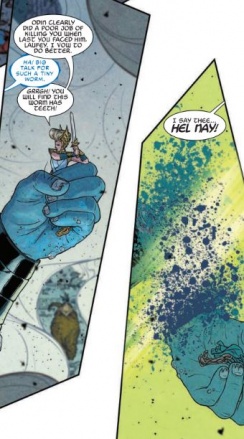
Dauterman. Wilson. Sabino.
Freyja, Loki, Odin, Jane and Thor Odinson, they are our POV characters, with varying degrees of focus, and the narrative positions shifts to accommodate them and their changing roles. The story opens on Odin, shifts to Thor Odinson, and transitions to Freyja before adding Loki in. Then Loki dies and we cut to Thor Odinson in Jotunheim. Issue two is Jane, Odin and Freyja’s. Issue three remains in Jane’s POV, as her position as all-mother and war commander precludes the wider-scope and allows us insight into the greater war.
Issue four does the same as Freyja captures the black bifrost, Dauterman’s paneling cueing us into who’s showing us each scene thanks to the purple/black smoke of Malekith’s secret portal, while Odin fights his way back to consciousness and Thor back to the realm he was so violently ripped from by Malekith-As-Loki. Issue five does the same, only this time Thor’s lightning provides the uniting thread across the battles, with a check in on Jane. Issue six is firmly with the Thors. . .and Loki, surprisingly enough.
Can I also comment on how many fake-out deaths there were? Seriously, I cannot believe how many there were. It’s like every issue! Loki is eaten in issue #1 and turns out to be alive in issue #6 (more on that later.) Odin is presumed dead twice, once in issue #1 and a second time with Freyja in issue #4. Thor could have been thought dead for most of issue one but, let’s be honest, that was never really implied. Even Mjolnir comes back from the dead! The only characters who remain killed by the end of the series are the villains and all the Valkyrior, who were technically dead to begin with but I’m not wading into those waters.
But, that’s also kind of the point.

Colors by Wilson. Letters by Sabino.
In norse mythology, Ragnarok in the end of all things but it is also the beginning. Cycles are important and death is never really the end. So too with here. The dead are still around, only now in a different realm. The ones believed dead return, not the same as they were before, but changed.
Jane once again takes up the mantle of Thor, perhaps for the final time, claiming the War Thor’s Axe-Hammer, and joins the trio of Thors as they go off to fight Malekith, before then taking the fight to Laufey, the focus of her very first mission as Thor. In fact, Dauterman & Wilson’s tenure on her title featured far less Odinson and far more Jane, making Thor Odinson’s absence all the more logical for the era the art evokes.
Continued belowFinally, the opening to issue #1 is echoed in issue #6, both literally and with the focal character, but, as with all good cycles, it ends with a change. We opened on a recounting of a creation story, yes, but also with the All-Father on his broken throne in an abandoned Asgard, brooding and bitter, hoping to see his son again. We end, too, on the All-Father but now he stands tall, above his father who is kneeling with humility and praise, having just been passed the title. It is fitting and telling that we end the issue, and the event, not on the defeat of Malekith, not on any denouement from the war and its effects, but instead on this sudden moment.
While it may have been more traditional to either end with the defeat of Malekith, the check-ins across the realms, and teases of things to come or with a more lengthy conversation between characters, this tiny scene was the perfect conclusion. The battle is done, the war is over but wars do not end cleanly. There is always rebuilding and while that may be outside the scope of the title, its beginning is always the final act of war. So, we must signal to that, and what better way than with the Odinson having earned a second title, that of All-Father. I have a feeling he’ll take to it in much the same way he did to Thor back in “The Mighty Thor” #706.

“Thor” Year 7
Act 3: Stories from the Front Lines – ‘War of the Realms’
You may be wondering: why is this guy, who has taken great pains to approach the many series of Aaron’s Thor in chronological order, punting the three interstitial “Thor” issues to after “War of the Realms?” Why not thread them in act by act, as they fell in the narrative? Simple. I wanted to talk about the event as a whole, presented as it was.
“War of the Realms” was a complete epic in three acts, in six issues, with a beginning, a middle, and an end. It did that with magnificent efficiency and the title stands on its own as a satisfying read. The rest is extraneous, even the “essential” issues of “Thor” (2018). You don’t have to read a single tie-in to understand, be moved by and enjoy “War of the Realms.” Do some issues deepen the narrative? 100% and I would say you should absolutely read the “Thor” (2018) issues as they were released chronologically but it won’t matter to your understanding if you don’t.
(For the curious: “WoTR” #1, “Thor” #12, “WoTR” #2-4, “Thor” #13, WoTR #5-6, “Thor” #14, though you could flip #6 & #14 if you wanted.)

War of the Realms #1 pg. 19
Dauterman. Wilson. Sabino.
The shape of this arc, much like ‘Road to the War of the Realms,’ is piecemeal but cohesive, and focused not on Thor but instead on three characters adjacent to him. As “War of the Realms” tie-ins, they’re directly related to the events of the issues and, as should come as no surprise, mirror Aaron’s ethos to Thor’s presence in that book; namely, he isn’t really present in the first two. Part of this is because there is little more to be focused on. “Thor” (2018) is about the Odinson grappling with being Thor again and having to take the lead on fight to stop the oncoming war. Now that the war is here, that motivation is gone and so following Thor here rather than in the main title would undercut the work being done there thematically.
Practically, it would also undercut the tension of where Thor is, what he’s doing, and what’s he thinking during those first four issues. . .also it would be entirely berserker rage battles and while that may make for a fun action scene, it would be useless fluff that serves neither the story nor the characters. Instead, Aaron chooses to take the opportunity to provide intimate counterpoints to “War of the Realms,” remaining true to its focus on Thor’s family while also following up on themes and events set up in “Thor” (2018) and before that would not fit into the main narrative.
Continued belowIf “War of the Realms” is the macro, then “Thor”(2018) is the micro. If the war is about selfless fighting the selfish, then “Thor” is about the selfish fighting to be selfless.
OK, enough prologue, let’s get to the issues.
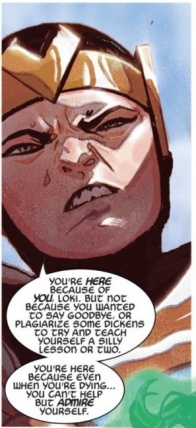
Art by Del Mundo. Letters by Sabino
Issue #12, as referenced above, takes place directly after the events of issue #1 of “War of the Realms” by revealing that 1) Loki is not, in fact, dead and 2) that he damn well wishes he was. It’s the first nod to the audience that, well, even the deaths that seem permanent most likely won’t be, but that doesn’t mean the actions or events are pointless. Loki sacrificing himself is not undercut by him surviving being swallowed and cronched by his father Laufey because it wasn’t the death that mattered; it was the willingness to sacrifice himself to save Freyja, instead of sacrificing Freyja to save himself, that did. Plus, the merits of the issue allow it to stand on its own.
‘The War of the Loki’s’ takes the form of a modified Dickens’ “A Christmas Carol,” visiting Loki upon past, present-ish, and future versions of himself. Mike Del Mundo draws the hell out of these locations and his eye for fantasy environments, making them look all at once otherworldly and distant while also being vibrant and familiar, is always a treat.
I particularly love the way he draws the many Loki, with Loki the Necrogod being a particularly different interpretation than before, reamed in the red of Ego’s lava and deep, shimmering obsidian. Mundo’s style fits this Loki like a glove, allowing him to be menacing and goopy thanks to all those strands of necro energy. It is a shame we don’t get more of it but as the last bit of connective tissue to this final battle, it is well worth it.
Why this issue here though? Other than the events of the war allowing for this to come to pass, why is it that we’re getting this introspective look at Loki now? The answer lies in the purpose of these stories; namely, these are the tales of the unworthy in the moments they learn what worthiness is.
Loki has been searching, throughout Aaron’s run, to find his place in the Marvel Universe. No longer was he the epitome of villainy, the Ur -Avengers antagonist, the bringer of Ragnarok . No longer was he a child, tricky, conniving but ultimately on the side of good, or at least adjacent to them. Now he was back, through an act of destruction of the self, and. . .he felt lost. He wanted to be better, to grow, but he could never shake either his reputation nor his penchant for trickery and deceit.

Art & Colors by Del Mundo. Letters by Sabino.
He stabbed Freyja because he believed it would prove his worth to Malekith, so he could take him down from the inside, but that action only made things worse. He failed because it was a selfish action; it was done out of love, yes, but love more for the idea of being a hero than for the people he believed he was saving. His sacrifice to Laufey was the reverse, but even with that noble gesture, he can’t shake the demons that haunt his brain nor the guilt he feels.
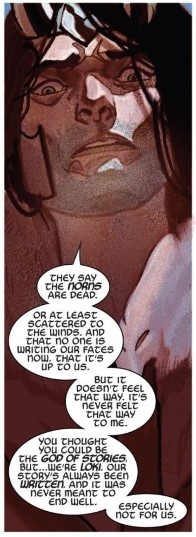
Issue #12 pg. 15. Del Mundo. Sabino.
As much as Aaron lampshades the Dickensian approach to this issue, and Kid Loki is right about the internal motivations — i.e. to make the story about him, to centralize himself once again, to say he birthed the war, he perpetuated it, and that he will survive it not as the hero he wants to be but as the ultimate destroyer he wished he would never become –he retains the moralistic argument at the center of the practice.
Loki brings himself on this journey through his past, present, and future to learn a lesson, yes, but not the lesson we assume it is. He is not learning about how he becomes a better person or how his actions this day, by being eaten, prevent a worse legacy down the line. It isn’t even a guilt trip to either absolve, by pinning it on his former self, or to condemn, by reminding himself that he squandered the first real, good thing by usurping his child version and betraying the one person who still believed in him. Instead, he reminds himself that his strongest trait, his best weapon is his ability to delude himself, the narration of his first lie being a helpful and powerful frame for it.
Continued belowHe did not birth Malekith’s love of war, though he contributed to the one that did, and while it can be argued that Viking Loki is lying to himself when he declares that the war that birthed Malekith was inevitable, it is a half-truth at best. He did perpetuate it, however, and Kid Loki calls him out. Present Loki tells himself, time and again, that his actions in the present were just and what “I had to do. To save her.” But that is another lie, another justification for what were villainous acts.
Finally, we have Loki the Necrogod and the revelation that, well, maybe the biggest lie Loki told himself, that things do not end well for him, was true. But, in that, remains one more piece of self-delusion. Loki, Vintage Loki, Present Loki, what have you, is being digested while he strolls through these moments. He believes, is convinced, that not only is he dying but that he must die. Why? Because if he doesn’t, then all those actions, all that pain and suffering he caused by his justified attempts to do right by doing wrong, were for naught. He ends where he always believed and feared he would: at the end of time, still fighting his brother, never having grown or succeeding at becoming worthy of the love his mother placed in him.

Loki’s story is one of tragedy and inevitability and it is in the moment he awakens in the gullet of his father that he realizes why, all throughout the war and before, he has failed at being worthy of the reincarnated life he gave himself. It is because he believed his story to be set in stone, his role opposite Thor as immutable, so that he had to act within those confines to accomplish any good. This was, and perhaps remains, his greatest lie.
Following up on Loki’s adventures in digestion, we have the tale of what Cul Borson has been up to since his fall from being chief jackass of Asgard. ‘The Ballad of Cul Borson, God of Fear’ channels issue #10, ‘A Boy and his All-Father,’ in that it does the difficult work of making a thoroughly despicable character sympathetic without sanding down the rough edges of them. Standing in contrast to Loki, who has clearly been misguided in his attempts to do good, Cul has never entertained those pretenses and so the issue reflects that.
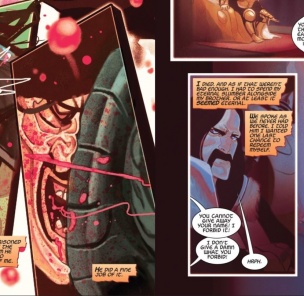
Del Mundo with D'Alfonso. Sabino.
We are treated to a brief walk through Cul’s life, seeing how it reflects Loki & Thor’s own youths like a funhouse mirror, in all his cruelty and bitterness. And yet, it is a heartrending issue. Yeah, a stand-alone issue about Cul Borson, god of despots and fearmongers, was heartrending; that is the power this team is capable of.
Aaron’s narration provides the perfect frame, setting a mood of contemplation, while Del Mundo delivers on heavy action and big emotions. Props go out to his and D’Alfonso’s coloring work, which has the difficult task of balancing the heavy shadows and darker visuals inherent in a story such as this with the usual vibrant, artificial-fantasy-flavored colors. For example, the restraint shown on page 8 contrasts gorgeously with the page that came before it without sacrificing the sheen or the consistency.
The same is true for Sabino’s always excellent lettering, cascading down the pages in spaces built for them, never crowding the art nor compromising itself. One nice touch is how the balloons overlap, with the person in power speaking first, trapping the subordinate’s speech between their own. While it is clearly a space saving tool, this light overlapping helps guide the eye in an unobtrusive manner across each panel, to the art and not just next to it, setting the pace for the issue and the mental wheels that turn for Cul.
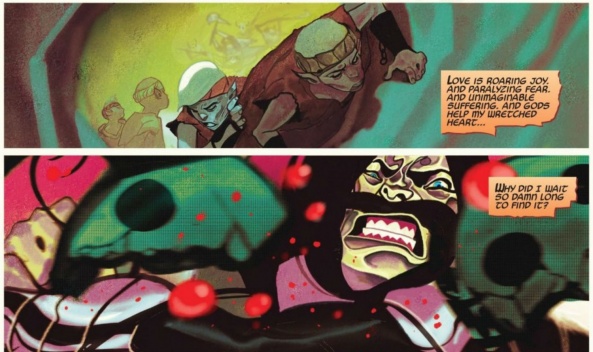
Cul has a complete arc in this issue, going from the revenge-filled God of Fear to Cul, Breaker of Chains, though it is easy to argue he had already come to this realization by the time he began his narration, as he talks about squandering every opportunity he was ever given, before hiding defensively behind false bravado and uncaring. But the cracks are there and as the issues creeps closer and closer to the opening moment, to the choice he must make, he reflects on his own life and the ways his own fear, his fear of disappointment, has shaped his actions and his failures.
Continued belowCul is still the cruel god he always was, admiring Malekith for his use of children in the mines and plotting to overthrow his brother to bring back his reign of terror. But, much to our, and his own surprise, by the end of ‘The Ballad,’ he has progressed upon the path of redemption and reiterated Aaron’s thesis from the previous arc, that love is the tool of the worthy and it is through acting with, and expressing love that one can find themselves upon the path to worthiness.
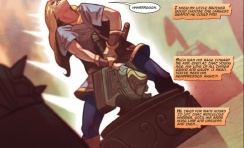
Del Mundo with D'Alfonso. Sabino.
This does not absolve him of his past actions, just as Loki’s sacrifice does not negate the harm he did, but it demonstrates his ability to change and vindicates Odin, once again mirroring the rocky relationship between Loki & Thor. Cul redefines love through his own lens but it is still there and it is in that moment, through an action born of love, that a legacy is finally built for Cul.
It has been a bit since we last checked in with Young Thor, who still remains unworthy of this Bor-damned hammer, filled with a rage not seen since “Thor: God of Thunder.” As I said earlier, this trio of issues focuses on the unworthy finding worthiness. Loki’s is the most abstract, Cul’s is very straight forward, and Young Thor’s, well, it’s simple but quite different from the previous two. For one, it is drawn by Scott Hepburn and colored by Matt Wilson, who brings a far more traditional look to the issue, with chunkier, more realistic characters, a darker and dirtier look, and simpler paneling. For another, it occurs in concert with the final issue of “War of the Realms,” only from a different perspective.

Colors by Wilson. Letters by Sabino.
While this may seem like a waste of an issue, the expansion and deepening of the battle with Malekith is welcomed and provides the kind of focused, character work that “Thor” (2018) has come to be. As I’ve said many times above, “War of the Realms” was a birds-eye view of the war, a general’s perspective, while “Thor” (2018) and the many tie-ins act as the soldier’s view, the ground level moments and acts. Young Thor is a soldier in this war, brought in to fight with all his bravado alongside the other Thors, and his is the perspective we get because, one, it allows Aaron to write a more irreverent issue and, two, he has the farthest to grow.
I love this choice, personally, because it is reflected in all aspects of issue #14. The narration is young Thor’s, the visuals are how he sees it, and the fights are filtered through his experience of them. Take the splash page of the four Thors and compare it to Dauterman & Wilson’s version.

Art by Dauterman. Colors by Wilson. Letters by Sabino.
Theirs is a two page spread, bright and triumphant, with Avengers Thor leading the pack, slightly larger than Jane, who is smiling, with King Thor and Young Thor, who is drinking from a horn of mead, the same, smaller size. Of the four, King Thor is the closest to the same in both.
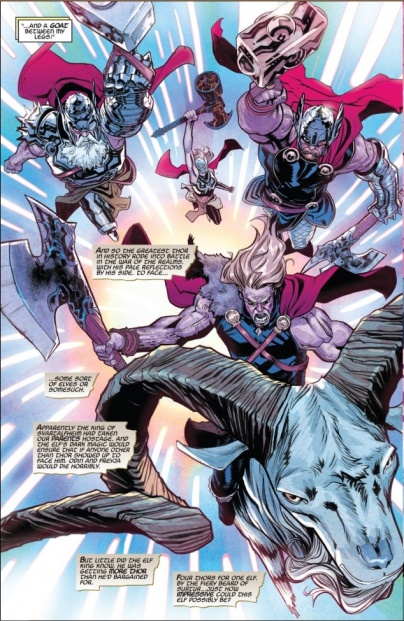
Art by Hepburn. colors by Wilson. Letters by Sabino.
Hepburn has it on one page, with Young Thor leading the charge, enraged, as is everyone else. He is the largest on the page with King Thor and Avengers Thor behind and slightly smaller but of equal size to each other. Then, way in the back, is Jane Foster’s Thor, who’s expression cannot be determined, her hammer far more prominent than her. The narration is flippant and self-centered, exactly as it should be from this impulsive, prideful, youthful version of the hero. He has yet to find himself, to find the greater lessons in life and so he rests on his anger and passion, powerful tools but fickle and easily expanded, as he finds out as the battle with Malekith’s dogs and Svartalvenom rages.
Continued belowThis is how he sees himself and his enemies. He is the center of the action; if something happens to him, the others suffer. Malekith is a monster with a faceless army of monsters and hellhounds and he is just some schmuck with an axe that has yet to be worthy of the hammer. He is filled with such insecurity that he hides behind bravado and pride, just as Loki and Cul before him.
‘To Hell with Hammers’ also addresses more explicitly the question of how all three of these Thors remembered their time with Gorr in the ‘Godbomb’ arc if it supposedly faded from their memories when they returned to their times, a nice nod to the last time these three were fighting alongside one another. It being fuzzy and only sharp once they were together again is a neat way of getting around the paradoxes. The same is true of the nebulous time of when this Thor is from.

Hepburn. Wilson. Sabino.
It precedes ‘Young Thor’s Lament,’ for at that point he had given up on the hammer, spending more time on Midgard in merriment than on Asgard in anger but it also follows his adventures in “Thor: God of Thunder.” Because of this, it can be read that the events of this war, were he to have remembered it on some deep level, primed him to receive Erica’s love and to take to heart that lesson. For that is what made Young Thor worthy here: the love of his mother and acting in defense of that love; it is also why he gives the hammer back to King Thor at the end of the issue.
It seems counterintuitive. Here is the god who has spent an entire 20 pages bemoaning that the rest of these Thors have hammers and he does not, obsessed with the object to the point that even after saying he wants nothing to do with it any further, he risks his life to grab it in the vain, prideful belief that he’ll be able to lift it for the glory of single-handedly winning the war, and then he rejects the hammer once he has it? Why? Simple: only someone willing to do that is fit to pick it up.
He could not lift the hammer when his thoughts centered on personal glory and how the hammer will allow him to achieve that. Instead, it is in the moment he let his thoughts go to another, towards protecting someone he loves, and away from how a hammer is the only way to help him do that, that he became worthy of using it to achieve his goals. He learned that the object is unimportant and not the end of the journey, that there are other things that are more important than some chunk of Uru.
Young Thor may not be a better person than he was on page one, he may not be less prideful or self-centered, but he has had a moment of clarity and in that moment, he found worthiness, even if it is fleeting and doomed to fade.
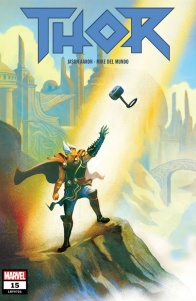
“Thor” Year 7
Epilogue to a War: ‘War’s End’
“Thor” (2018) broke the established patterns for Aaron’s epic. Gone were the clear interludes between arcs, in their places were character focused one-shots that had the semblance of an arc. And so it is fitting that we end in a non-traditional manner. Why not put this issue with the above? Well, it is an epilogue to the “War of the Realms,” picking up literally where it left off and once again featured Thor as the main focus. It is a send off for the war rather than a part of it, it is the aftermath and the mission statement for what comes next. It should also be read before the ‘Omega’ issue of “War of the Realms,” hence the split between this issue and the next.
Issue #15 is as much a thesis statement as we’re going to get on the series. Aaron has been a bit more heavy handed with his theme during “Thor” (2018) and this issue is no exception, having Thor monologue to himself, then himselves, and then to his parents. However, the words he says rings true. I have little to add to them here; I have spoken ad nauseum about the revelations he had during the War about worthiness. What I will add is that ‘War’s End’ shows Thor now at his most conflicted.
Continued below
Art by Del Mundo. Colors with D'Alfonso. Letters by Sabino.
He had finally found who he was and what he wanted to be when another destiny was thrust upon him. All-father? How can he be All-Father when he barely knows how to be Thor? He runs from that destiny, just as he did from being re-given the moniker Thor, because he does not feel he is worthy of it. However, as he states, worthiness is not a state, it is a process. It is a struggle and while he may struggle to feel worthy of the throne, he will build it into something he feels proud of. That is not something he can done alone nor will it be what came before.
Mjolnir was destroyed and reforged anew, but not the same, created from the storm of four Thors as well as the God Tempest. Thor, though worthy once again, is not the same as he was nor is his worthiness based on the same mindset. So too with Asgard. It cannot return to what it once was but it can be rebuilt. It must be new for it to thrive and for it to be worthy of returning. This is what Thor realizes and considers before accepting.
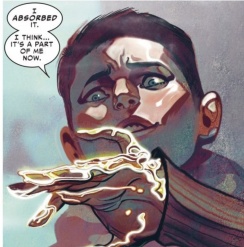
Colors with D'Alfonso. Letters by Sabino.
As for the rest of the issue, it is a grab bag of teases – Jane Foster and the All-Weapon, the rebirth of the Valkyrie, Loki, now king, and the struggles he will have upon his throne in Jottenheim, — as well as the ultimate fate of Malekith and a moment that began in “War of the Realms” #6 but is completed here: Odin finally saying the words he was too afraid and proud to say for eons, brought to our attention in issue #10. are explored. While that Odin hugging the Thors splash page was a cathartic and highly earned moment, Malekith’s fate is the most interesting part of this issue.
What do you do with the man who put the ten realms at war? You can’t send him back to the pits of Nastrond, he’ll just break out and torture doesn’t do anything to him. . .or, at least, traditional torture doesn’t. The reveal that the innocent Malekith, him as a boy, remained in his soul still, leads us to believe that, perhaps, there was still a shred of good in Malekith and watching that goodness be destroyed over and over again would be torturous to him.
However, in a twist that is delightful, Malekith is tortured by being forced to watch his boyhood self be given peace, playing with dogs and cats in a field. For what is Malekith without war? Where would this part of him go when the war is done and the bodies no longer need burning? What was all that pain for, if the war ever ends?

Art by Del Mundo. Colors with D'Alfonso. Letters by Sabino.

“The War of the Realms” Year 7
‘Omega’
I’m not going to spend a lot of time on this ‘Omega’ issue for one reason: it has very little to do with either the “War of the Realms” or Thor. It is a teaser for things to come from unresolved “War of the Realms” threads but beyond that, offers very little in the way of new material to analyze for this column. Loki is now king in Jottenheim, taking to it with glee and trickery, the Punisher made a promise to a man who had just lost his family and intends to keep it and, just as there must always be a Thor, there must also always be a Valkyrie, so it seems Jane Foster’s time leading a double life is not over yet.
It is a good issue, though extraneous to the event, with a frame that closes the book on the God Without Fear while opening up these other three narratives. The war may be over but its effects are still felt reverberating throughout the realms.
Continued below
“Thor” Year 7
The End: ‘Once Upon a Time in Asgard’
Twelve issues into “Thor: God of Thunder,” the team did something different. Gorr had been defeated and instead of thrusting Thor off into his next adventure, they slowed down and showed what the God of Thunder was like on a day to day basis, how his fight with Gorr had changed him and why he was worthy, though he did not realize it. It was an issue entitled ‘Once Upon a Time in Midgard’ and so we return to that mode, before the final battle, before Ribic’s art takes us to the end of the universe, with ‘Once Upon a Time in Asgard.’
A celebration of who Thor is as well as a send-off for all the work that Aaron had done thus far, ‘Once Upon a Time in Asgard’ is about as perfect an ending as you can get. It has all the feel of a party that has died down, when most of the guests have gone, so all that remains are your close friends, a few chairs, and the quiet of a room that once was packed with noise. It is an intimate time, one that brings out hidden truths and somber moments, but also the most joyous and raucous laughter.
Issue #16 takes stock of where Aaron is leaving his supporting cast. Odin may be going senile, though if I know anything, it is a ploy to hint that Cul may have survived the mine’s destruction, though I hope not. Heimdall is back and seeding the bifrost garden, a visual that looks like a garden of candy, beautiful and sweet.

Roz is steaming over Agger getting off scot free, lamenting she couldn’t have shot him more. Volstagg is back on his feet and welcoming T’challa to the Congress of Worlds while the new League of Realms, complete with Lady Waziria, continue their quests, hunting down Scumtongue the Tongueless and the possibility of one of the lost Norns.
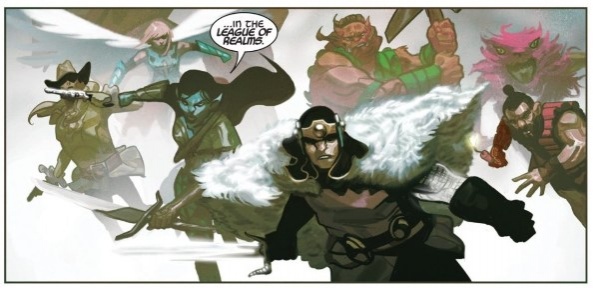
Ulik, Enchantress and Sindr are trapped beneath the watchtower tree, grown from Yggdrasil. Beta Ray Bill and Throg watch as trolls help rebuild Asgard, now assured a place in the realm once built, allowing Thori to find peace, one he welcomes, a moment of growth for the goodest of murder dogs.
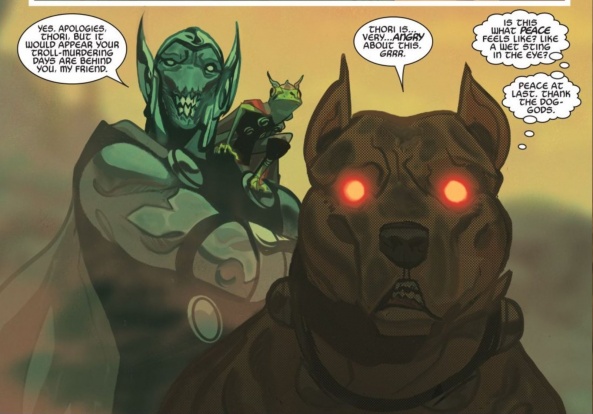
We get one final scene from Loki, who revives Toothgnasher, before leaving for solitude, a moment that breaks your heart for the God, now King, of Stories. We listen as Freyja frets over Laussa with Gaea, the challenges of her marriage to Odin clearly not behind them but, perhaps, more manageable than they once were.

Odin gives his speech to Freyja, worried that he’ll never gets to tell his son all the good he has done, how inspirational he has been and to vocalize all the love he never did before while Valkyrie gives her own short speech to the crowd.

We send off Young and King Thor alike to their respective times, one having grown, ready for the world ahead of him, and one feeling empty, returning to a universe that is dying, not ready for the final battle ahead of him.

And through it all, we see Thor, going from one location to the next, helping as only he can, with his hammer, and with his kindness. He may not be accompanying a newbie S.H.I.E.L.D. cadet to her S.H.I.E.L.D. prom but he does bring food and, I presume, farming knowledge to the Dark Elves of Svartalfheim, rebuilds a welcoming church in a less than welcoming environment, and sends a heart from one end of Australia to the next in order to save a girl’s life.
Continued belowAll-Father Thor is a lofty title, one composed of names given to him by others, one he is not comfortable using or claiming as of yet. He wonders, with each action, whether he remains worthy, knowing that that was the very thing that made him so.

Art by Del Mundo. Colors by D'Alfonso. Letters by Sabino.
Every Ending is a New Beginning, and No Event Occurs in Vacuum: “War of the Realms” Tie-Ins
And so, we reach the end. Or, rather, an end. This is the final issue of “Thor” (2018), the final adventure of Present Thor as written by Aaron but not the end for Aaron’s run. There are still four more issues to discuss, a story of Necroblades and the end of the universe, but that we shall save for another time. I will also save the goodbyes and the conclusions for then. Instead, let me send you off with some optional reading, insofar as any of this was really “mandatory.”
Below are all 52 of the tie-ins for “War of the Realms” in a presentation format that may seem similar to readers of Jake’s Mutantversity column. That’s because I cribbed and modified it from him because he does this every month and dammit if I’m gonna let him upstage me with his ~consistency~ and ~pithiness~ and ~attention to detail.~
Yes, I did say all 52 of them and yes, I did read them at least twice, thank you for asking. I do a lot for y’all and it’s nice to be appreciated. However, unlike above, please don’t take the opinions below as 100% critical reviews because I found it more fun to try to do a balance of fast-ball comedy and loose critique so all numbers are BS and not indicative of comparative quality.
What I appreciated most about these tie-ins is that they fill-in the details of how the war affected the whole world, as well as each character set, while still remaining focused and not being necessary to following the event. They add flavor and that’s what a good tie-in should do, even the ones I didn’t love so much.
Want a full, chronological reading order list? Here’s Justin Beeson’s comprehensive list. It’s good, though I disagree with the “essential reading” category since, for once, the extraneous issues really aren’t important for the shape of the event, though the ones he highlights are the closest to “essential” reading as you’ll get.

Art by Luca Maresca. Colors by Federico Blee. Letters by VC's Cory Petit.
“Asgardians of the Galaxy” #8: Artist #1 takes the stage and over three quarters of the issues are two-page spreads with variations on “The Battle Continues” across the top. Bleh. Dry humor of the changes gets a chuckle. Standard battle fare but devoid of any of the panache of the main title exciting or the pathos would get us through it. It’s all quips and spectacle but without the spark that makes it work. Throg is the closest but not even the Frog of Thunder can save this issue from mediocrity. 2/10
“Asgardians of the Galaxy” #9: Big jump between issues and events feel like there’s something missing to connect them. More standard battle fare with artist #2 and it’s just kinda OK. Art oscillates between way too heavy shadows and very bright lighting. Brunhilde’s death doesn’t have the same impact as the main title. Are she and Malekith made of swords? The characters still feel stock and undifferentiated but we finally get that kiss and a resolution for Annabelle that is not explored in the main title when Brunhilde is killed. This title being around allows for her to live, so for that, it gets a 10/10.
“Asgardians of the Galaxy” #10: End of a series, end of a tie-in. OK wrap up, tries to go for big emotional moments, doesn’t quite land. Heven is done for though. Guess we’re back to 9 realms? Resolution to Angela’s arc in “Thor” (2018) and that sweet, sweet comeuppance. Artist #3 comes in and completes the two-page-spread-o-rama battles. This could have been two issues and been a much tighter adventure, felt like it had to fill time until the death of Brunhilde and then faff about at the end of the war. 3.43244/10
Continued below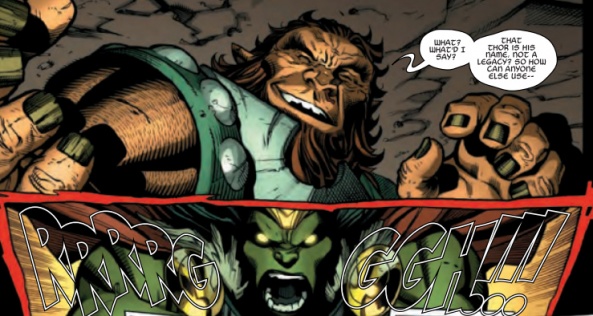
Art by Ed McGuinness & Mark Morales. Colors by Jason Keith. Letters by Cory Petit.
“Avengers” #18: Color me intrigued. Not a single avenger in sight but a thoroughly engaging issue. Reveals, secrets, and deals with the devil abound while providing commentary on the military industrial complex’s control of what we view as victory and who we value. Plus, the full-on return of the Squadron Supreme in that mighty Direction Competition fashion. Ed McGuinness draws the hell out of this issue and it’s the perfect balance of heroics and unsettling spy work. 10/10
“Avengers” #19: Gorilla-Man takes the lead and, once again, the war is more backdrop for character work and long-term story planning. While it may not have the same impact one those not reading “Avengers,” the issue is told in such a way that it doesn’t matter. The mountain attacks and speak! McGuinness does creepy vampire dog beautifully and this issue fills in the details of how the various factions knew where to go. Additive to the main narrative without being technically necessary. 9/10
“Avengers” #20: She-Hulk gets her spotlight and, like Gorilla Man, it’s introspective and enlightening. Jennifer has gone through a lot recently and this helps situate us with where she’s at. Plus, watching that troll get beat up was great. Daredevil gives us some choice prophecies that, a few months down the road, we know about half of, in traditional Aaron fashion. All in all, 10/10 Hulk punch. And, on a serious note, thank you Justin Ponsor for your contributions to the previous two issues. You were a colorist taken too soon.

Art by Annapaola Martello. Colors by Tamara Bonvillain. Letters by Clayton Cowles.
“Captain Marvel” #6: Body-swap time. Art is a bit wobbly, with dirty linework, but the expressions hit and get the job done. Thompson is the queen of banter and putting a very tired Captain Marvel and Doctor Strange together with Natasha is a recipe for hilarity. Takes a bit to get going but when it does, it does in spades, hitting those great empathetic notes and we get to watch Carol yell at Stephen for being a shitty teacher. Surprised he hasn’t had to deal with this before. 8.43543/10
“Captain Marvel” #7: Nat is the best and that fight with the crocodile behind the emotional bonding scene was *mwah* fantastic. Good wrap up and a fun team-up. Captain Marvel and Doctor Strange should do this more often just so I can see them snipe at each other more. Art is much more solid this issue, though the faces do sometimes get a bit wonky. 9.21321/10
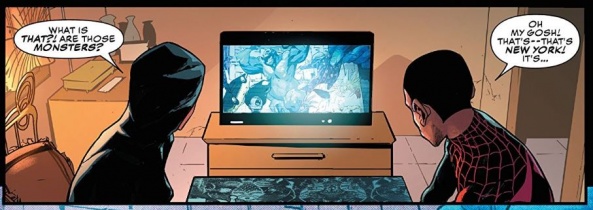
Champions #5 pg. 3. Art by Juanan Ramirez. Colors by Marcio Menyz. Letters by Clayton Cowles.
“Champions” #5: Now THAT’S a tie-in. Self-contained adventure while hitting all the emotional beats necessary to make us care about these characters, fills us in on the previous issues without overburdening us with info, and takes the time to make it more about the heroes than the battle. Miles at the beginning and that Ms. Marvel & Scott scene, powerful stuff. It’s a “Champions” book first, and a tie-in second, just like the best of them should. Scott Summers may usually be a dick but here he’s pretty chill and gets a great intro moment. 11/10
“Champions” #6: A solid stand-alone that acts as a piece of an arc. Juggling this many characters is difficult, and it doesn’t always work, but Power Man gets a nice moment and then also a moment of “seriously, dude?,” highlighting the tensions in the team. Kinda extraneous to the war but that was a good backdrop. Though, where Miles was is a big question. 8.453/10

Art & Colors by Nick Klein. Letters by Jeff Eckleberry.
“Deadpool” #13: Quips Galore, the Merc with the Mouth just won’t stop talking and it’s just kinda OK. Felt more exhausted than giggly, even with the great Australian Daredevil gag (Chip Zdarsky? That you?) For the start of a two-parter, it sure wastes a lot of time. Deadpool subjecting Negasonic Teenage Warhead to all his favorite Rom-coms on the flight is gold tho. 3.8528/10
Continued below“Deadpool” #14: Somehow Daredevil fighting trolls in Australian is just kinda. . .dull? How is the quipmaster general this dull? Am I jaded? I appreciate the constant self-deprecation on Scottie’s part, Klien’s art is a visceral joy to look at, but the whole thing feels extraneous and ultimately pointless. Ulik the Conquerable, though. Classic Deadpool reversal. 3.25423/10

Art by Paco Medina & Kevin Libranda. Colors by Jesus Aburtov. Letters by Joe Caramagna.
“Fantastic Four” #10: Angst angst angst angst angst angst. Franklin is the Incredible Angst and it’s pretty annoying. I love how The Thing is drawn, even if he looks too shiny and the whole adventure wraps up quite fast, feels like two issues in one. Nice job integrating it into the main title tho, made Yancy Street feel alive and bringing in Lunella was a nice touch. 5.985/10
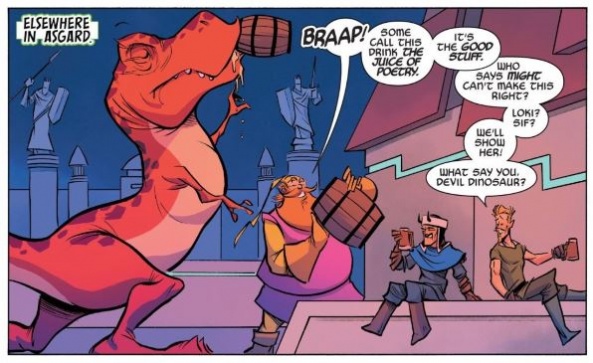
Art by Gustavo Duarte with Ray-Anthony Height. Colors by Tamra Bonvillain. Letters by Travis Lanham.
“Moon Girl and Devil Dinosaur” #43: Joe Kill is my new favorite Frost Giant and Dino-Thor made me groan so hard. Not my cup of tea but a nice Asgardian romp for the title, though FF crossover would’ve been nice. About as disconnected a tie-in as you can get, thankfully it’s a stand alone issue. Issue felt a bit underdeveloped, perhaps due to the simple paneling and slide-show-esque presentation in art and dialog. Really only for fans of the series and even they may just want to skip it. 4/10. Sorry Lunella, not your strongest outing.

Pencils by Lan Medina. Inks by Cam Smith. Colors by Andy Troy & Erick Arciniega. Letters by Travis Lanham.
“Superior Spider-Man” #7: The die is cast! 6.742/10
“Superior Spider-Man” #8: Of all the tie-ins, this feels like the most old-school. Lot’s of editor’s notes, lots of connective tissue between the tie-ins and a ton of cameos. Gwenpoole felt off, like a serious, paired down version of herself, but her speech at the end was exactly what was needed. Otto is a diiiiiick and watching him get called out for his bullshit is always entertaining. West Coast Avengers sans Jeff (#justiceforjeff,) dragon lady who I am ashamed to have forgotten, and Kate assembly! That’s their cry, right? 7.4345/10

Art by Paolo Villanelli. Colors by Edgar Delgado. Letters by Joe Caramagna.
“Tony Stark: Iron Man” #12: Definitely one of those tie-ins that work better when you’re reading the series itself. Dragon vs Iron Man fight plus Iron Cat and Rhodey in a tank? Yes please. A bit wordy but the banter flows. Guess this all takes place right before the war? 5.565/10
“Tony Stark: Iron Man” #13: Tony Stark is of the DCU confirmed. He spoke the Wizard’s name and channeled his mystic lightning. Janet is Fae and Tony gets his armor ripped off in a very strategic fashion. Two-parter wrapped up quite nicely, nice thematic resonances. There was a storm of frogs so that gets a 8/10.
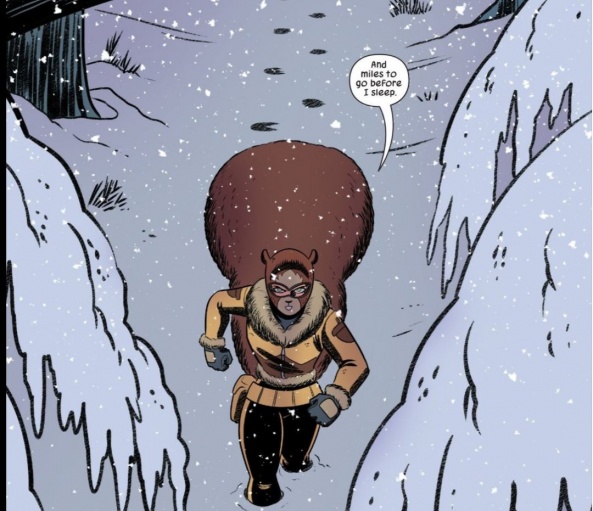
Art by Derek Charm. Colors by Rico Renzi. Letters by Travis Lanham.
“The Unbeatable Squirrel Girl” #43: I. Love. Allene’s. Design. So much. I wish we got more of her but I know why we didn’t. Doreen’s winter costume is also amazing and Derek Charm really stepped up for this arc. That is all. Nothing else to see. What War of the Realms? What Loki? What start to the best tie-in of the entire event? 15/10 Nothing beats this series.
“The Unbeatable Squirrel Girl” #44: Every panel in this issue is a gem and you will be laughing the whole way through. Also, it is super dense, just like the whole series, but one that makes you appreciate the page length rather than resent it. Rachel Oskar is tons of fun, Scarlett Q. Goryle is my new undercover name, and Rachel shape-shifting into Doreen but “evil” aka w/ skimpier, dark clothing and thinking it’d be best for her was 100% on brand and only the 5th best gag of that page. 17/10 Petition to change Friday to Ironmansday? Oh, and nice hint at the final arc there.
Continued below“The Unbeatable Squirrel Girl” #45: Taking the time to slow down and appreciate the scenery with a well timed poem, tears were brought to my eyes and then a swift Hel Yeah from my mouth. Doreen hasn’t been this angry in a while and Rachel is clearly testing her patience, despite actually trying to earn that second chance she was given. It’s a great dynamic and the comedy remains on point. 15/10
“The Unbeatable Squirrel Girl” #46: A deeply satisfying ending to this four part arc which sees Doreen, I kid you not, save the whales. Yes, we went full Star Trek: IV on ya right before inciting a revolution against King Laufey with the power of a well reasoned argument. Also, Rachel Oskar is now an investigative journalist and that is the best use of her talents. If you missed this series, read the whole thing now. Do it. This arc is a teaser for all the fun and damn fine storytelling done throughout its run. 20/10

Art by Iban Coello. Colors by Andres Mossa. Letters by Clayton Cowles.
“Venom” #13: Standard superhero event-tie in. Poor follow up to the actual ongoing. Narration is very heavy handed in recap and vocalizing emotion rather than complimenting it. Art’s ok if a bit muddy and plastic-y at parts. Eddy often looks carved like a Ken doll. Why is Jack O’Lantern important? Oh and “Curse your sudden but inevitable betrayal”. 4.0558/10
“Venom” #14: Once more, same as before. Middle chapter works a bit better as it’s mostly fight scenes. Still fairly surface level stuff with Venom, rehashing the old. Villain is crazy stupid one dimensional and not in a fun way. Art’s much more solid, save for the final two page spread having a confused eye line. 3.0002/10
“Venom” #15: Clever defeat of Jack. Never quite pushes the dream stone aspects to their full potential but armoring up civilians was a nice touch and twist on We are Venom. Still pretty standard fare in the narration and was it actually Jack and he was lying or was it really a nobody? A somewhat fun, if not particularly new tie-in that never quite knew what it wanted to do except have a battle and have Eddie… Learn? 4.6/10

Art by Marco Castiello. Colors by Rachelle Rosenberg. Letters by Joe Sabino.
“War of the Realms: Giant-Man” #1: Intro to four Giant-Men, only two of which I knew about before reading this. Banter is the right balance of fun, sniping, and stoic seriousness. Artwork reflects the harsher tone of the story and the higher stakes, though can be a bit too restrained with muddy inks. Leah Williams flexing her tonal muscles by juxtaposing the intense danger with hilariously corny operation names like Masters of Disg-Ice. 9/10
“War of the Realms: Giant-Man” #2: Dammit Leah! Stop hitting me in the feels! I didn’t come to read a Giant-Man comic to feel sad; I came for jokes and for frost giant fights. Razzum-frazzum fantastic character work and humor that remains congruous and so much more thought out than the usual quippy snark that Marvel has become known for. For a middle chapter, the momentum is kept high and the stakes remain dire. Let’s hope they all make it out in one piece. 10/10
“War of the Realms: Giant-Man” #3: Damn if that wasn’t a fine ending for a fine mini. It’s no wonder Leah Williams is our Breakout Writer of the year. Taking a silly concept and making it profound without dismissing the silliness is hard to do but it was done here. I could’ve used one more issue but better to be wanting more than begging for the sweet release of death. Plus, Cassie’s wasp outfit is dope and I hope we get more of her, Nadia and others soon. 11/10 It’s not a tear in my eye, just some frost.
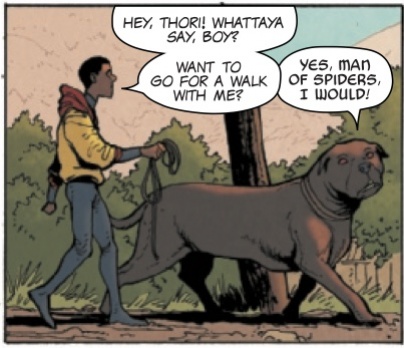
Art by André Lima Araújo. Colors by Chris O’Halloran. Letters by Clayton Cowles.
“War of the Realms: Journey Into Mystery” #1: Bombastic first issue that, in true Journey into Mystery fashion, focuses on one of the other Odinson’s, this time Balder. . .And Laussa Odinsdottir, who hasn’t been seen since “Angela: Asgard Assassin.” Love the team montage and Balder being surprised by the legacy characters because he’s been away just that long. Best gag has to be the dancing LMDs. 11/10 Thori is here and we got a Spiders-Man reference.
“War of the Realms: Journey Into Mystery” #2: The jokes keeps coming and they won’t stop coming. Get to the camp, gonna hit the ground running. Thori hates cats and the skrulls hate fun, once they saw the baby, their minds went numb. So much to do, so much to say, who knew diapers smelled like an ashtray? You’ll never know if you don’t go (Go!). The art is still by Lima Araujo.
Hey now, book’s an all-star. Got its game on, did. great. Hey now, it’s a rock star. Got its story strong. Got. Made. Kate’s, the, best, HawkEYE. This song pa-ro-dy, has gotten, dry–ee–eye. (11.5/10 Thori is still here and the quips are tighter)
“War of the Realms: Journey Into Mystery” #3: Wild west ghosts and all the antics that come with it. Love the way the McElroys use the different strengths of the characters to move the narrative. A real team book and living up to the Journey into Mystery title. Oh, and a reminder that Laussa is a demon. Whoops! 12/10 Thori gets some A+ lines and that two page spread was just *Chef’s hand kiss emoji*
“War of the Realms: Journey Into Mystery” #4: Stakes are raised, Ares finally arrives and we get another weird adventure tangent for our road trip crew. A bit slow but so fun it doesn’t matter. Miles makes it rain and he’s so proud of himself. 9/10 Thori is beaten up.
“War of the Realms: Journey Into Mystery” #5: What a twist! Or, maybe not. Still, solid ending to, perhaps, the weirdest of the tie-in minis. The charm and quips and brevity of dialog was just what was needed to keep up the pace and the “turn your enemies into friends” thing is always fun when earned. Sad this didn’t spin off into a new volume of “Journey” w/ this team. Truly a dream team. 10/10 Thori rides again

Art by Gang Hyuk Lim. Colors by Federico Blee, Andres Mossa, and Erick Arciniega. Letters by Clayton Cowles.
“War of the Realms: New Agents of Atlas” #1: How to efficiently introduce, like, 8-10 heroes in a tie-in mini without it feeling overstuffed and connecting it to the main event while still having it be its own thing in 22 pages or less 101. Pacing could be better, feels like there were a couple pages cut from the top for space BUT none of that matters because IO THE MAGIC BEAR. 10/10
“War of the Realms: New Agents of Atlas” #2: Second verse same as the first. 2nd chapter sets the stakes, Muspelheim invades, the team starts to get together and we have some ~drama~. 8.086858/10 not enough Io.
“War of the Realms: New Agents of Atlas” #3: I just noticed Sindr’s got these weird boob cones. Think Madonna but made of rock and, like, 2x bigger. It’s… a design choice for sure. Spam lunch may make me sick to my stomach but the cross-cultural moment of unity was a perfect scene, being a needed respite from the fighting, both physical and verbal, a moment of connection between characters, and a great gag turned booyah moment. Shang-Chi shutting fools down is also the big mood. 7.9866/10
“War of the Realms: New Agents of Atlas” #4: Twist! Pele is a robot. Seems. . .forced but ok. Jimmy Choo is another in a long line of team mentors who keep major secrets but at least he’s not evil or bad, just strategic. Nice wrap up, feels a bit padded and Sun Wukong feels underdeveloped but considering the number of characters, that’s to be expected. 7.2468/10

Art by Marcelo Ferreira. Colors by Rachelle Rosenberg. Letters by Cory Petit.
“War of the Realms: Punisher” #1: If there’s a war, Punisher is going to be there to fight in it. Solid first issue, establishes stakes and sets a VERY different tone to the rest of the event. Light narration was a good call. Ferreira brings a clean, brutal line to the page but perhaps too heavy an ink, especially at the end. And did they really have to do another wife and kids death? 5.75456/10
“War of the Realms: Punisher” #2: Flashback is well timed and gives us some humanity to the murder robot Frank Castle. Mostly a slaughter with an OK amount of tension. Curse your sudden but inevitable betrayal, prisoners. Frank Castle is an asshole. Opens on NJ bashing. -10/10 how dare Duggan go for the low hanging fruit.
“War of the Realms: Punisher” #3: Frank Castle looks like a Raisin with a gun one panel and it is amazing. The rest is kinda meh. Frank Castle is an asshole, the motivations for his indiscriminate slaughter of these prisoners is weak at best, and it’s all just kinda lackluster. Plus, we never do see that giant again. The small focus was a good choice, though. I’m just not much of a Punisher guy so this tie-in, while a good way to show the street level of the war, was very extraneous for me. 3.454/10
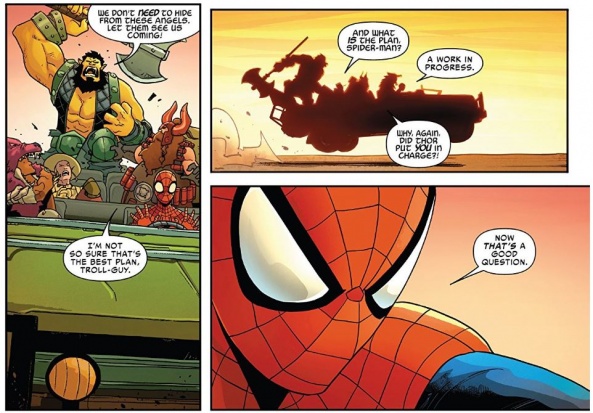
“War of the Realms: Spider-Man & League of Realms” #1: Side quest Ahoy! Spider quips and heart are on point, the rest is a bit thin and one-note. As a start to a mini, it’s fine. The league of the Realms is back and that’s really all that matters. Oh, and this is what Kurse has been up to. 6.8358/10
“War of the Realms: Spider-Man & League of Realms” #2: Opens on vanilla, PG-13 implied Angel sex. Then buried gay via backstory. Decent fight scenes and Spider-Man remains the strongest character, with Fernande a close second. 2/10 Malekith sucks and dead girlfriend trope is kinda getting old, though the case can be made that the title, “Why We Fight,” speaks to its inclusion as another commentary on the reasons and motivations that drive conflict and conscience, with each issue being a spotlight on a different character (Spider-man, Fernande, Kurse)… I promise more jokes soon.
“War of the Realms: Spider-Man & League of Realms” #3: Great character moments with Fernande and Kurse. Love in the Air? League reformed and Waziria is back baybeee. Solid ending to a solid mini tie-in. Kurse editorial box relates to the Daredevil War Scrolls story so trade readers have it. 7.095/10
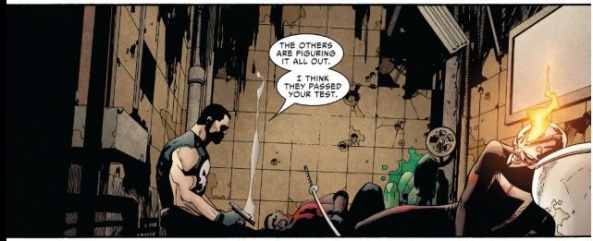
Pencils by Lenlil Francis Yu. Inks by Gerry Alanguilan. Colors by Matt Holingsworth. Letters by Joe Sabino.
“War of the Realms: Strikeforce: Dark Elf Realm:” So that’s how they prepared for the mission to destroy the Black Bifrost. Meditation on war and another damn Frank Castle book. How does one let darkness in without becoming of it? There is no easy answer and they don’t try. A bit grim and self-serious, taking a few pages to really get going, but a good issue otherwise. Punisher sucks for the first 10 pages, then his purpose becomes clear and clicks, but it still feels shaky. Same with the motivations and fears for the heroes, they feel half formed and too simple. Punisher got a chuckle out of me though so I call that a win. 6.23489/10
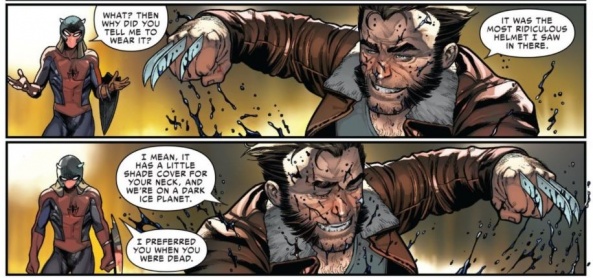
Pencils by Jorge Molina. Inks by Adriano Di Benedetto. Colors by David Curiel. Letters by Joe Sabino.
“War of the Realms: Strikeforce: Land of Giants:” Dammit Taylor, making me cry, making me laugh so hard I could cry, making it so now I’ll always associate berserker rage with viking tantrum. Spidey is the other hero with a lot of tie-in presence here but I prefer more of him, especially under Taylor’s mix of heart and ridiculousness. A helmet that lets you talk to horses, who would’ve thought it’d be such an important item? 9/10
Continued below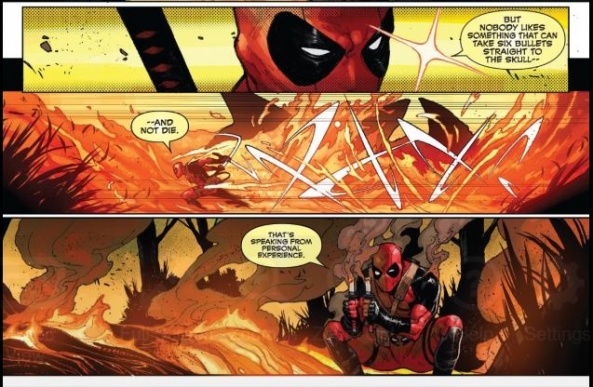
Art by Kim Jacinto & Ario Anindito. Colors by Java Tartaglia & Felipe Sobreiro. Letters by Joe Sabion.
“War of the Realms: Strikeforce: War Avengers:” Murder Clown and the Killy Bunch are at it again, this time bouncing from fight to fight in an OK tie-in. Another issue about war and what its like to fight it, the characters feel a bit underdeveloped so the ending doesn’t land as it should. Fun battles though and sets up why and how they were in Britain for “War of the Realms” #3. 6.43245/10

Art by Pere Pérez. Colors by Rachelle Rosenberg. Letters by Travis Lanham.
“War of the Realms: Uncanny X-men” #1: Say what you will about the issue, you certainly get your money’s worth. Waaaaay too much happens and why is everyone, everyone deeply unlikeable? Scott Summers is a dick, yeah, but everyone else is just as bad. 90% of this issue is fighting, and only 20% of that is with fists and villains; the rest is all interpersonal sniping and I feel exhausted after one issue. Kudos on that and making the war feel like, well, a war and not one on the road to victory. 3.482/10
“War of the Realms: Uncanny X-men” #2: I wish I cared more about these characters than I did. Fights are great, good middle chapter, the way Rahyne Sinclair’s affectations are written still annoys the hell out of me. The tonal whiplash between super casual conversations and hyper-dramatic X-antics are still going on. Also, Rahyne has a son? And when was Magick kidnapped? Hope Summers and Alex “Don’t call me the M-word” Summers are also both dicks. 4.32143/10
“War of the Realms: Uncanny X-men” #3: Rosenberg really hates Rahyne Sinclair, doesn’t he? Granted, this book has way too many characters to juggle and new readers will be lost as all hell but still, that felt rushed and unearned. Nice use of the portal. Also, why isn’t Dani Moonstar the new Valkyrie? I love that it’s Jane but, like, I had no idea she was one before this mini & the lackluster, milquetoast reason she doesn’t become the next one ala Jane is baffling. “The X-Men are needed.” Yeah but there are like, 200 of them? 2.342/10 Not actually that bad but, like, this was an unsatisfying mini for a non-“Uncanny X-Men” fan and surprisingly wordy.

Art by Joe Quinones with Joe Rivera. Colors by Rico Renzi. Letters by Joe Sabino.
“War of the Realms: War Scrolls” #1:
‘The God Without Fear’ #1: Wilson coloring Sorrentino is very weird but makes the whole thing far more Marvel than Sorrentino’s coloring. Wonderful side quest for our newly empowered Murdock, properly epic and the fights are rendered with pizazz. 8.832/10
‘The Warriors Three (Or Four):’ Lesson learned, reformation of the Warriors Three achieved, Volstagg food joke complete. All in all, solid story with some fun easter eggs and cameos by Cloak and Dagger. Art reminds me of Spider-Gwen with its thin outlining and voluminous stretching. 7.8232/10
‘Nice Shot, Frank:’ Somehow Ram V made me like Frank Castle and gave him and Wolvie some fantastic banter. Love me a good inspirational speech to remind us why the street level tales and limited scope of short stories like these are important to tell. 8.94584/10
‘Waugh of the Realms:’ Zdarsky & Quinones & Rivera & Renzi are at it again for four pages of Howard the Duck tomfoolery and irreverent humor and BIGGS THE CAT. 100/10 Best comic ever. Nothing you say will change my mind.
“War of the Realms: War Scrolls” #2:
‘The God Without Fear’ #2: Twists and turns and an examination of Murdock’s fears and doubts. Sorrentino shines in his portrayal of scale and his Fisk looks like a pruney thumb, which I get a kick out of. Continues to be a fantastic battle in the war. 8.86855/10
‘Agency:’ Doctor Strange on a mini adventure to Eternity and Nightmare’s realms. Nice follow-up to his spell gone wrong and a treatise on agency in the face of danger. Plus, always fun to see a villain defeated without a single punch. 7.8546/10
Continued below‘My Drag Brunch with Loki:’ A caveat to the Loki issue of “Thor” (2018), featuring the best of the Gillen-McKelvie-Wilson era Young Avengers. Great character work, keeps the story focused, and felt much longer than it actually was in the best of ways. You feel for Loki while also hating him along with Wiccan. Plus, Wiccan and Hulkling are the best couple, why don’t we get more of them? Title is a giveaway for the twist though. 9/10 More of this drag bar please and BEAR KID THOR YES.
“War of the Realms: War Scrolls” #3:
‘The God Without Fear’ #3: Fantastic conclusion to a fantastic story. Does exactly what a tie-in should do with flourish and grace. Scope remained focused and emotional beats hit hard. 10/10 would read again.
‘A Rose for Victor:’ The kind of experimental short that you hope to get from these anthology issues. Doom, through the eyes of a soldier and child. It’s almost as good as when the Latveria soccer team was imprisoned for treason! Love the way the narration and art interact and tell two different tales of Doom. Also, Doom in battle is gnarly but also hilariously stretched. 8.755/10
‘The Face of a Warrior:’ She-Hulk smash awkwardness. Freyja and She-Hulk have heart to heart while Blade & Punisher discuss album tastes. This is everything I didn’t know I wanted from this crew. 9/10 Not enough Swamp Dragon.
Join me again in a week for the finale of Worthy, as we take a look at the end as it reflects the beginning in “King Thor.”
Part 1: ‘Worthy’
Part 2: ‘The Death of the Mighty Thor.’
Part 3: ‘Thor in Hel and Other Stories.’
Part 5: ‘King Thor’






